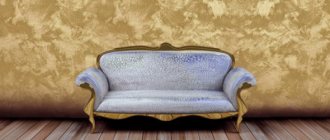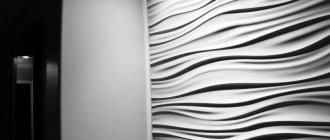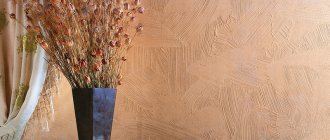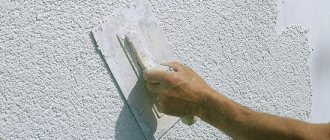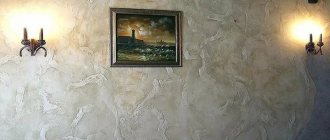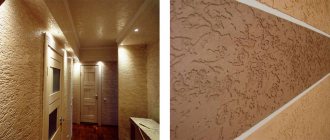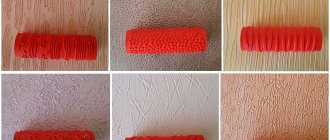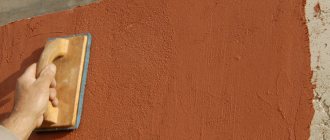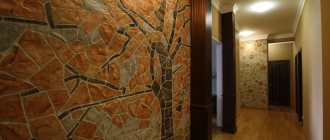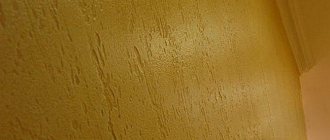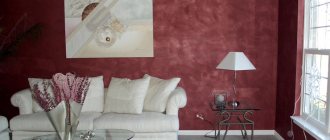Before you begin any type of work, you need to acquire all the equipment. Then the process will go much faster, because you won’t have to be distracted by looking for a small device that you can’t do without.
Applying decorative plaster is no exception. There is also a minimum set that allows you to do everything correctly and quickly.
What is hidden behind the word “trowel”, and what types of it exist?
Neither a mason nor a plasterer can do without this tool. One name hides a large number of devices that have a similar structure, but perform different functions:
- Mason's trowel - has the shape of a triangle with a smoothed top or a trapezoid. Using this tool, the mortar is collected and distributed over the brickwork. Also suitable for mixing small quantities of solution.
- The jointing trowel is used to refine the seams of brick or stone masonry. The working surface of the tool is always narrow, but the configurations are different (flat, concave, convex - the appearance of the seam depends on the shape).
- The finishing trowel is always trapezoidal. With its help, it is convenient to mix the plastering solution, collect and measure bulk substances.
- The plaster trowel has the shape of a drop, with a handle attached to the wide part of it. Using this tool, it is convenient to apply a solution of any components to the wall and level it.
- The trowel is a flat rectangular trowel. It is used for leveling and rubbing mortar that has begun to set. Creates a smooth and aesthetic surface.
- A corner trowel is suitable for making even corners of a building. There are options separately for internal and external wall joints. Some stores also offer universal devices.
- The notched trowel is used to apply adhesive to tiles or mineral wool. It is similar in appearance to a trowel tool, but has jagged edges on one or two edges.
There are other types of this tool, which, of course, are not necessary to buy if in the future there are no plans to professionally plaster facades. Some options are interchangeable. All presented trowels have one design, which consists of:
- Metal plate - the material is well ground and polished. The size and shape of the working part differs depending on the type.
- Handles – made of metal, wood or plastic. There are options with a combination of materials.
- Curved transition from plate to handle. Each tool is different, since the bend is adapted to a specific type of work.
Attention! When purchasing, make sure that the tool is comfortable to hold in your hand, as well as the condition of the metal plate. If there is a defect, do not take such a trowel.
Spatula for decorative plaster
A spatula for decorative materials can be an excellent replacement for a trowel. There is a wide range of spatulas that are used by professional craftsmen. Using a spatula you can achieve the same results as when working with a trowel, so using it is an excellent alternative when choosing a working tool.
Angular
To finish corners or places where walls meet the ceiling, use a corner spatula. It consists of a plate, the sides of which are perpendicular to each other, and a handle. Thanks to the special shape, the master can apply the finished solution to corner surfaces, which allows the material to be smoothed even in hard-to-reach areas.
Facade
Typically, a thick layer of plaster is used for the facade, since in this case it is important to create a durable and moisture-resistant coating. In this regard, when performing external work, wide facade spatulas made of stainless steel with a durable plastic handle are used. The wide part allows you to apply a large amount of material at once and distribute it along the wall. The main selection criterion in this case is the width of the working part and the strength of the material from which it is made.
Painter
You can see examples of painting spatulas in photos and videos online. This model is a small triangular metal plate with a handle. Using the presented tool, you can perform minor work when finishing walls.
Rubber
The work can be done using a rubber spatula.
A rubber spatula allows you to evenly distribute the finished mixture without scratching the surface of the walls.
The tool is a small piece of durable rubber of varying widths and thicknesses. One end is cut at a certain angle, and the other end has a special handle. Usually, the seams on the tiles are rubbed using a rubber spatula. It is also convenient to use when working with rounded surfaces.
Plastic
A plastic spatula is practically no different from metal options.
This model is intended for wallpaper, since it helps remove excess air from under the material.
However, professionals in the field of construction and renovation recommend using it for applying plaster coating. The strength and elasticity of the material make it easy to do the job.
Japanese spatula
A special model designed for working with Venetian plaster is made of stainless steel. The model is a metal plate with a signature red badge in the center and a plastic handle on one side.
The solution is applied using a spatula according to the following algorithm:
- A small amount of the mixture is applied to the edge of the work surface.
- The master distributes the material in different directions over the entire surface, while monitoring the thickness of the coating.
- After the first layer has dried, the material is reapplied.
- In the final stage, after the plaster has dried, the walls are finished.
Multifunctional
A multifunctional device can be useful when performing various repair and finishing work. The spatula is an unusually shaped device made of a high-quality metal plate with a plastic handle.
The presented option allows you not only to apply a plaster solution to the walls and ceiling, but also to remove old wallpaper, paint, whitewash... You can also use it to open cans of paint, pull nails out of the walls and form a pattern on the surface, distributing the solution over the coating.
Types of finishing rollers
A simply plastered facade is boring, so the owners come up with different ways to make the appearance original.
The creators of construction tools picked up this idea, and now there are rollers that can be used to create interesting and unique designs on wet plaster. These tools will be divided according to two criteria:
- the material from which they are made;
- final drawing.
Let's start with the first point. In relation to the material, rollers are:
- Plastic ones are the most popular among beginners. They are easy to work with. They leave a clear pattern in the form of brickwork or a clear pattern. Their price is also attractive. But such rollers are only suitable for a small area of work. With constant use, cracks or chips appear, which distorts the result.
- Wooden ones resemble their plastic counterparts. Over time, the wood swells and the design loses its clarity. If you plan not to use the instrument for a long time, dry it thoroughly.
- Rubber - this type of roller is used by professional craftsmen who constantly work with decorative plaster. They are expensive, but retain the size and shape of the pattern for a very long time, regardless of the frequency of use. In addition, to obtain a high-quality ornament, special working rules are followed.
- Leather - you can’t do without them when creating Venetian plaster. Genuine leather leaves an imprint that resembles a pattern on marble.
- Fleecy - made from natural or artificial fur. Before purchasing, decide what effect you need. The smaller the pile on the tool, the smoother the surface will be. Longer hairs will create a bright and unique pattern. This roller is suitable for creating a “fur coat” on the facade.
- Foam rubber - seal craters or traces of burst bubbles on wet plaster.
As for the pattern created by the roller, there are the following options:
- Imitations of textures, for example, marble, wood, pile. Leather, fleecy and fabric tools are suitable for this.
- Applying a clear pattern or ornament. In this case, choose a wooden, rubber or plastic option.
What tools can you use to create relief?
To create three-dimensional patterns on plastered surfaces, special tools and devices are required that create different types of original textures. You can achieve the required relief using:
- Sponges. Used to create a bubbly texture, as well as for coloring and partial coloring of structured surfaces. One of the possible effects that can be achieved when painting with a sponge: aged plaster.
- Structural rubber rollers. A ready-made pattern has already been applied to such a tool, and to transfer it to the wall, it is enough to run a roller over the not yet dry plastered surface so that they leave a textured imprint on the wet layer.
- Fur rollers. Allows you to create a grassy structure and chaotic patterns of even stripes on plaster.
- Leather rollers. Such an instrument is made of artificial leather (crumpled, twisted, corrugated, secured in pieces). Depending on the type of roller, you can create reliefs with different effects.
- Film rollers. Tools coated with crinkled or spirally wound polyethylene film, creating a light relief and original structure on surfaces covered with decorative plaster.
- Needle rollers. Create a uniform decorative surface with a dot pattern.
You can also use improvised objects to create decorative reliefs:
- plastic bags;
- latex gloves;
- pieces of tires;
- wrinkled fabrics;
- ropes;
- brushes.
What will you need?
Plastering the facade is carried out in several stages:
- surface leveling;
- applying a decorative layer;
- creating a drawing.
Each of them requires its own sets of tools, some will be useful both in the first and in subsequent stages. Before starting a specific area of work, all working equipment is assembled.
For surface preparation
Decorative plaster cannot hide flaws on the wall, so first the surface is leveled and a base is created for applying a decorative layer. In addition, additional plastering acts as insulation.
- Containers for mixing the solution.
- Hammer with mixer attachment.
- Plaster beacons are needed when the applied layer exceeds 1 cm. Although professionals recommend installation for beginners even with a smaller amount of work.
- Bucket for pouring mortar.
- The rule is to help quickly level the rough layer. Installed beacons will also speed up the process.
- Small spatula. With its help, it is convenient to remove the remaining mortar from the rule and add it to the wall in those places where there is not enough of it.
- A trowel or float to create the most even layer possible.
For finishing
After the rough layer has dried, you can apply the decorative plaster composition. Now use a different set of tools:
- Containers for mixing the solution.
- Construction mixer and hammer drill with attachment.
- Wide spatula for applying the solution.
- Ironing irons.
To create patterns
The most important and difficult stage is creating patterns. Here it is important to remember with what force and in what direction the first drawing was applied. It is advisable that one person work on the same area with the textured layer. Each drawing has its own device:
- "Bark beetle" - plastic graters. The pattern depends on the geometry of the movements (circular, horizontal, vertical, diagonal).
- “Fur coat” is a fluffy roller or an unnecessary piece of fur.
- Ready stamps. They are pressed tightly onto the dried layer of plaster and the design is imprinted.
- Rollers with a pattern.
- Available means are brushes, washcloths, a plastic bag or burlap wrapped with a regular roller.
Professionals who constantly work with decorative plaster come up with their own designs and patterns, as well as methods for creating them. In their work they use small spatulas, trowels of various sizes, a scraper and even cutlery.
Textured processing of the facade is a flight of fancy both for the owner of the house and for the craftsmen who perform the work. Not only the pattern and tools are selected, but also the color or method of painting.
For mechanization of work
If the amount of work is very large, then it is physically difficult to cope with everything. To make the application process easier, I use a plaster gun. Comprises:
- a compressor that pumps air;
- containers for solution;
- nozzles of different sizes through which plaster is thrown under pressure onto the wall surface.
The use of a mechanical method of applying the solution has the following advantages:
- Speeds up the application process.
- Allows the solution to adhere to the base 100%.
- You can control the thickness of the applied layer.
- Reduces the amount of waste in the form of splashed solution or fallen pieces.
- Simple technology of use allows even beginners to work.
- The applied layer turns out to be quite even, so you will have to work with the rule a little.
One disadvantage is the cost. It is not worth buying such a device for one-time use. If you want to plaster the facade yourself, it is better to rent a car from a construction tools rental company.
Professional tools for working with decorative materials
No surface finishing work is complete without the use of special tools. Using a trowel, spatula, brush or sponge, you can reproduce all kinds of patterns, ornaments, reliefs on the surface of the wall. The combination of several technologies and the use of several different tools is an opportunity to show your imagination, creating unique designs.
The quality of a professional tool directly determines the result of the work of a master decorator. To apply Venetian plaster or any other decorative material, you must use only high-quality tools.
Professional painting tools include:
- Trowel for applying decorative plaster.
- Plaster spatula.
- A grater is a tool for applying bark beetle plaster.
- Rollers for decorative plaster (textured, structural, rubber, relief, rollers for different types of work).
- Stencils.
- Decorative applicators (wood-like) and stamps.
- Brushes and combs.
- Sea sponges.
Trowel for applying Venetian plaster
This tool, made of stainless steel, is used for applying and leveling Venetian plaster. Using a trowel, a professional craftsman will skillfully recreate a beautiful pattern on the surface of the wall. The trowel also makes it possible to obtain a relief on a plane using various types of decorative plaster.
Spatula for Venetian plaster
Another type of tool for Venetian plaster is a spatula - this is a metal spatula, polished on both sides. A spatula for plastering walls is slightly different from a professional spatula for Venetian plaster.
Grater
Sometimes it is necessary to carry out work on applying plaster with the “bark beetle” effect. The result you get depends on the right tool. That is why when working with decorative bark beetle plaster, a special grater is used. With its help, drawing is carried out. During the work process, this tool is moved along the plane in a certain way, achieving the desired result.
Rollers for making patterns on the surface
With plaster you can create the most unusual patterns on the surface using various tools. To work with decorative plasters, many craftsmen use all kinds of rollers, which allow them to create various decorative designs on the wall. Due to the fact that the rollers are very easy to use, they can be used for both plasters and decorative paints. Decorating the surface using a relief roller is one of the options for stylishly decorating walls, combining several techniques of applying material and experimenting with shades of the coating.
Stencils for plaster
The pattern on the surface can be done differently. For this purpose, special stencils are used, with the help of which you can obtain various ornaments without much effort. There are many types of such stencils; they allow you to quickly and beautifully decorate a surface with original designs. To do this, the master does not need to have artistic abilities; he just needs to carefully apply the paint using the selected stencil.
Decorative applicator
If you want to create a pattern on the surface of the wall that resembles a “wood” pattern, then a decorative applicator will come to the rescue. It is a convenient tool equipped with a handle. The decorative applicator is used as a device for working with fine-textured plasters and decorative paints. Creates a pattern on the surface that imitates a “wood” effect.
Decorative stamp
For lovers of animalistic patterns, there is a special tool designed to create textures like the skin of a snake or crocodile. A stamp is perfect for these purposes, the use of which will provide unique patterns that imitate animal skin.
Three-sided comb
Using a three-sided comb made of rubber, various types of effects are achieved on decorative paints. The three-sided comb is made of rubber material. Using this tool, various effects are created on decorative paints and textured plasters.
Metal comb
This type of tool is used to obtain relief on decorative paints. The result of surface treatment directly depends on the technology of working with a metal comb and the level of professionalism of the master decorator.
Rubber bristle brush
This tool is also a device with which a decorative effect is achieved on paints and textured plasters.
All these, as well as many other professional painting tools, can be found in the SIGNUM Center online store. Our specialists will help you choose the right product, advising you on any issue that interests you. Your order will be processed as soon as possible and delivered to its destination. Contact us!
How to make a Venetian?
This decorative finish looks rich and attractive. With the help of the Venetian, they create the effect of marble or aged stone. You can apply this plaster to the base using the following tools:
- Containers for mixing solutions.
- Construction mixer.
- Compositions for tinting.
- Thin spatula for mixing and collecting mortar.
- Wide spatula for applying the solution.
- Skins for sanding.
- Rags.
To create Venetian plaster, several shades are used. To begin with, decide on color schemes. Then a base solution is prepared. This layer is applied continuously to the base.
After it dries, the second and third solution are lighter shades, which form the desired pattern. When everything is ready, you need to remove excessively protruding areas, sand them and, if necessary, open them with wax.
How to create complex patterns on a surface?
Drawing on wet plaster is not a difficult process, but it requires a responsible attitude and time. When applying, take into account the consistency of the solution, the tool with which they are working, and the strength and direction of pressure. But there are ways of decorating that only real masters can do:
- Stencil application.
- Modeling using plastic gypsum mortar.
- Varnishes that peel or tear as they dry. In this way, a multi-colored painted surface is obtained.
- Acid etching.
Plastering is not as boring as it might seem to an ignorant person. Solutions applied using different methods and tools create designs that are different from each other and allow you to create an original design not only for the interior of the house, but also for the façade.
